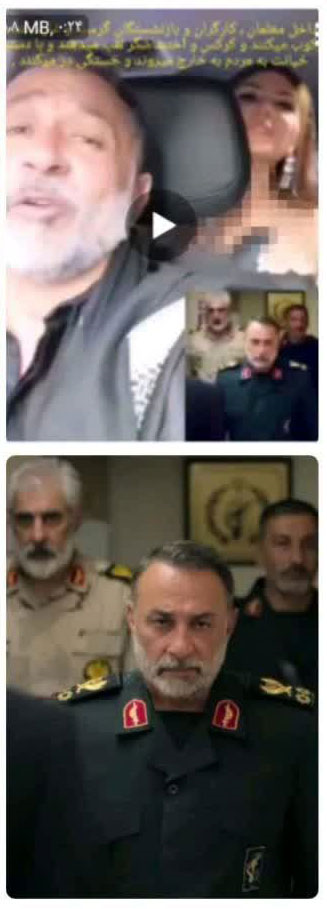
Clip of a video circulating on Iranian social media in which Iranians misidentify German-born Greek-Iranian actor Vassilis Koukalani as a Revolutionary Guards officer.
“A clip entitled, ‘IRGC Commander having fun with women abroad’ was released.”
Iranians are avid consumers of social media. However, the popular embrace of social media is a double-edged sword. The excerpted article from government media outlet Fars News Agency highlights Iranian efforts to counter misinformation circulating on social media.
Many Iranians, especially those who approach state-run television and news agencies with cynicism, get their news from social media. Telegram is popular. While the Iranian government discourages use of Facebook and Twitter, even Iranian officials use such platforms. During the 2018-19 unrest, security forces even circulated photos of protestors on Twitter to crowdsource their identification. Specifically, the Islamic Revolutionary Guard Corps (IRGC) denounce the legitimacy of two clips that Iranians said depicted the misbehavior and corruption of a senior IRGC officer, but actually show German-born, Greek-Iranian actor Vassilis Koukalani.
That Iranians so readily believed that Koukalani’s clips depicted IRGC corruption, however, reflects the cynicism with which ordinary Iranians view the institution and the hypocrisy that they expect from public figures. While Supreme Leader Ali Khamenei seeks to imbue revolutionary values in the next generation, it appears that multi-million dollar corruption scandals and human trafficking rings involving clerics have eroded public trust more broadly. The Iranian public’s readiness to believe ‘fake news’ regarding their leaders could also become a security issue for the regime. In 2001, an Iranian diaspora television channel broadcasting from California sparked nationwide riots when it claimed that Iranian authorities had ordered the national soccer team to throw an important World Cup qualifier to prevent men and women from celebrating together. Ironically, the excerpted Fars News Agency article will only exacerbate the regime’s credibility problem as Iranians could interpret the failure to correct future questionable social media stories as tacit admission that other videos and clips are real.
Source:
“Dorough-e Digar Aliyeh Sepah (Another Lie against the Revolutionary Guards),” Fars News Agency (official media outlet close to Iran’s security forces), 7 May 2022. https://www.farsnews.ir/news/14010217000011
Another Lie against the Revolutionary Guards
Recently, a clip entitled “IRGC Commander having fun with women abroad” or “IRGC Commander and his daughter dancing and singing in the car” has been released. The clip identified the person in the clip as a Revolutionary Guards commander.
But the fact is that the person in the clip is a German-born mixed heritage actor, and his photo in an Islamic Revolutionary Guard Corps uniform is related to his role in one of the Zionist, anti-Iranian films in which he has starred.
Image Information:
Image: Clip of a video circulating on Iranian social media in which Iranians misidentify German-born Greek-Iranian actor Vassilis Koukalani as a Revolutionary Guards officer.
Source: Fars News Agency
https://media.farsnews.ir/Uploaded/Files/Images/1401/02/17/14010217000003_Test_NewPhotoFree.jpg
Attribution: none
